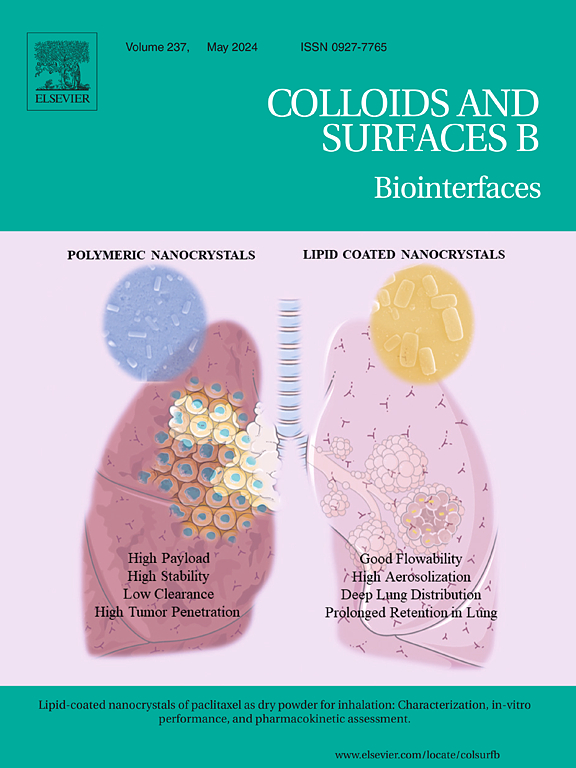Injectable glycol chitosan thermogel loaded with placental mesenchymal stem cells secretome for enhanced wound healing and tissue regeneration
IF 5.4
2区 医学
Q1 BIOPHYSICS
引用次数: 0
Abstract
Wound healing is a complex biological process that is essential for restoring tissue integrity and function. This study presents an innovative injectable thermosensitive hydrogel (thermogel) formulation based on hexanoyl glycol chitosan (HGC) loaded with placental mesenchymal stem cell (MSC) secretome to enhance wound healing and tissue regeneration. The GC-based thermogel is designed to promote the delivery of bioactive factors from the MSC secretome, including cytokines and growth factors, which are critical for the healing process. The thermogel exhibits favorable physicochemical properties, including a sol-gel transition at physiological temperatures and excellent structural integrity post-injection. In vitro studies demonstrated that the secretome-loaded HGC thermogel significantly enhanced cell proliferation, migration, and angiogenesis. In vivo experiments further confirmed that the thermogel accelerated wound closure and re-epithelialization in a murine wound model. These findings suggest that the multifunctional properties of this HGC-based thermogel, combined with the bioactivity of MSC secretome, offer a promising therapeutic approach for enhancing wound healing and promoting tissue regeneration.
负载胎盘间充质干细胞分泌组的可注射乙二醇壳聚糖热凝胶促进伤口愈合和组织再生
伤口愈合是一个复杂的生物过程,对恢复组织完整性和功能至关重要。本研究提出了一种新型的可注射热敏水凝胶(thermogel)配方,该配方基于己醇乙二醇壳聚糖(HGC),负载胎盘间充质干细胞(MSC)分泌组,以促进伤口愈合和组织再生。基于gc的热凝胶旨在促进间充质干细胞分泌组的生物活性因子的传递,包括细胞因子和生长因子,这些因子对愈合过程至关重要。热凝胶具有良好的物理化学性质,包括生理温度下的溶胶-凝胶转变和注射后良好的结构完整性。体外研究表明,负载分泌组的HGC热凝胶可显著增强细胞增殖、迁移和血管生成。体内实验进一步证实了热凝胶在小鼠伤口模型中加速伤口愈合和再上皮化。这些发现表明,这种基于hgc的热凝胶的多功能特性,结合MSC分泌组的生物活性,为促进伤口愈合和促进组织再生提供了一种有希望的治疗方法。
本文章由计算机程序翻译,如有差异,请以英文原文为准。
求助全文
约1分钟内获得全文
求助全文
来源期刊

Colloids and Surfaces B: Biointerfaces
生物-材料科学:生物材料
CiteScore
11.10
自引率
3.40%
发文量
730
审稿时长
42 days
期刊介绍:
Colloids and Surfaces B: Biointerfaces is an international journal devoted to fundamental and applied research on colloid and interfacial phenomena in relation to systems of biological origin, having particular relevance to the medical, pharmaceutical, biotechnological, food and cosmetic fields.
Submissions that: (1) deal solely with biological phenomena and do not describe the physico-chemical or colloid-chemical background and/or mechanism of the phenomena, and (2) deal solely with colloid/interfacial phenomena and do not have appropriate biological content or relevance, are outside the scope of the journal and will not be considered for publication.
The journal publishes regular research papers, reviews, short communications and invited perspective articles, called BioInterface Perspectives. The BioInterface Perspective provide researchers the opportunity to review their own work, as well as provide insight into the work of others that inspired and influenced the author. Regular articles should have a maximum total length of 6,000 words. In addition, a (combined) maximum of 8 normal-sized figures and/or tables is allowed (so for instance 3 tables and 5 figures). For multiple-panel figures each set of two panels equates to one figure. Short communications should not exceed half of the above. It is required to give on the article cover page a short statistical summary of the article listing the total number of words and tables/figures.
 求助内容:
求助内容: 应助结果提醒方式:
应助结果提醒方式:


